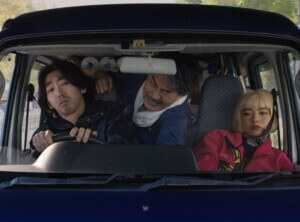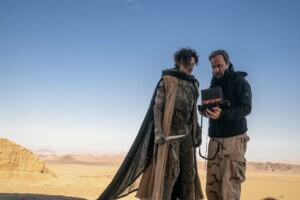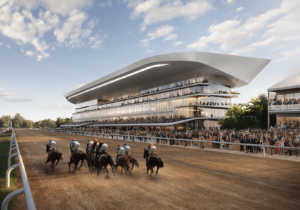World Premiere of Modern Ruin: A World’s Fair Pavilion
Friday, May 22nd, 2015
Cocktails 7:00–8:00p.m., Screening 8:00–9:30p.m.
Queens Theatre, 14 United Nations Avenue South
Flushing Meadows Corona Park, Queens
Philip Johnson and Lev Zetlin’s New York State Pavilion for the 1964 World’s Fair in Queens’ Flushing Meadows Corona Park should be more than an eyebrow raiser as those curious, disc-on-pole structures seen when driving to JFK airport. It was Munchkinland, the starting place for Dorothy’s journey to Manhattan—correction, Oz—in the 1978 film The Wiz. It was an alien spacecraft tower in the original 1997 Men in Black which crashes into the nearby Unisphere. And it was the site of Tony Stark/Ironman’s confrontation with his adversaries in Iron Man 2 on the grounds of Stark Expo 2010, a digitally updated 1964 World’s Fair grounds (director Jon Favreau’s childhood home overlooked the park). And it will appear in the new film Tomorrowland starring George Clooney that opens May 22.
But the common current perception of what Ada Louise Huxtable called “sophisticated frivolity” when the buildings opened is one of dereliction, decay, and outmodedness. That is, except for a number of dedicated citizens called People for the Pavilion and architectural simpaticos, who rightly see this as a preservation issue. What results is a new documentary called Modern Ruin: A World’s Fair Pavilion by Matthew Silva and executive produced by the makers of Modern Tide: Midcentury Architecture on Long Island (2014), Jake Gorst and Tracey Rennie Gorst, which will premiere the same day as Tomorrowland.
The towers were a favorite of master-builder and fair impresario Robert Moses, who saw these structures as one of the few 1964 World’s Fair buildings intended to live beyond the event. Paul Goldberger said it used “advanced engineering combined with a very exquisite sense of architectural composition, to make something that was both aesthetically and structurally quite beautiful and fully resolved.”
The pavilion consists of three components made of reinforced concrete and steel: the “Tent of Tomorrow,” the Observation Towers, and the “Theaterama.” The elliptical “Tent of Tomorrow” measured 350-feet by 250-feet with sixteen 100-foot-tall columns supporting a 50,000 square foot roof of multi-colored fiberglass panels—like a Rose window over a circus tent—once the largest cable suspension roof in the world. The Observation Towers are three concrete structures, the tallest at 226 feet high, with observation platforms once accessed by two “Sky Streak capsule” elevators. The adjacent “Theaterama” was originally a single drum-shaped volume of reinforced concrete where pop artworks by Andy Warhol, Roy Lichtenstein, Robert Indiana, and Ellsworth Kelly—plus art from local museums—were exhibited alongside a display from the New York State Power Authority featuring a 26-foot scale replica of the St. Lawrence hydroelectric plant. A 360-degree film about the wonders of New York State, from Jones Beach to Niagara Falls, was screened inside.
Warhol’s specially-commissioned Thirteen Most Wanted Men series depicting criminals’ mug shots straight on and in profile, displayed on the exterior had a fate reminiscent of Diego Rivera’s censored murals at Rockefeller Center: Nelson Rockefeller had it covered over, here because too many Italian Americans were depicted as criminals. (In 2014, the complete series was displayed at the Queens Museum, just 200 yards from the New York State Pavilion.)
The Theaterama was converted to the Queens Playhouse in 1972 and is now the Queens Theatre where Modern Ruin: A World’s Fair Pavilion will be screened.
Connecting the complex was a floor made of 4-foot-by-4-foot terrazzo panels that formed a map of New York State. In fact, it was a Texaco roadmap and was a great hit with people finding their home towns and navigating across the state. At the end of the fair, the floor was supposed to be moved to a building in Albany, but instead was left and became a roller rink—terrazzo is a great skating surface.
The site was largely intact until the mid-1970s (the Grateful Dead and Led Zeppelin performed there), but its fate was part of New York City’s downslide. The roller rink closed, the roof was taken out. Left open to the elements, the mapped floor was destroyed.
Since that time, the complex has continued to deteriorate, but a handful of dedicated citizens have devoted themselves to resurrecting the space. Volunteers for the New York State Paint Project are sprucing up the tent with a fresh coat of paint. CREATE Architecture Planning and Design came up with an idea to make it into an Air & Space Museum—that plan went nowhere. In 2014, New York City government announced a pledge of $5.8 million towards rehab of the structure, and Governor Cuomo’s office pledged $127,000, but estimates for the complete rehabilitation have climbed to a staggering $75 million.
The film is a loving portrait with intelligent interviews with Frank Sanchis (World Monuments Fund), Robert A.M. Stern, and Paul Goldberger laced among those who created, remember, and are saving the site.










